wallywhy150 Reviewed
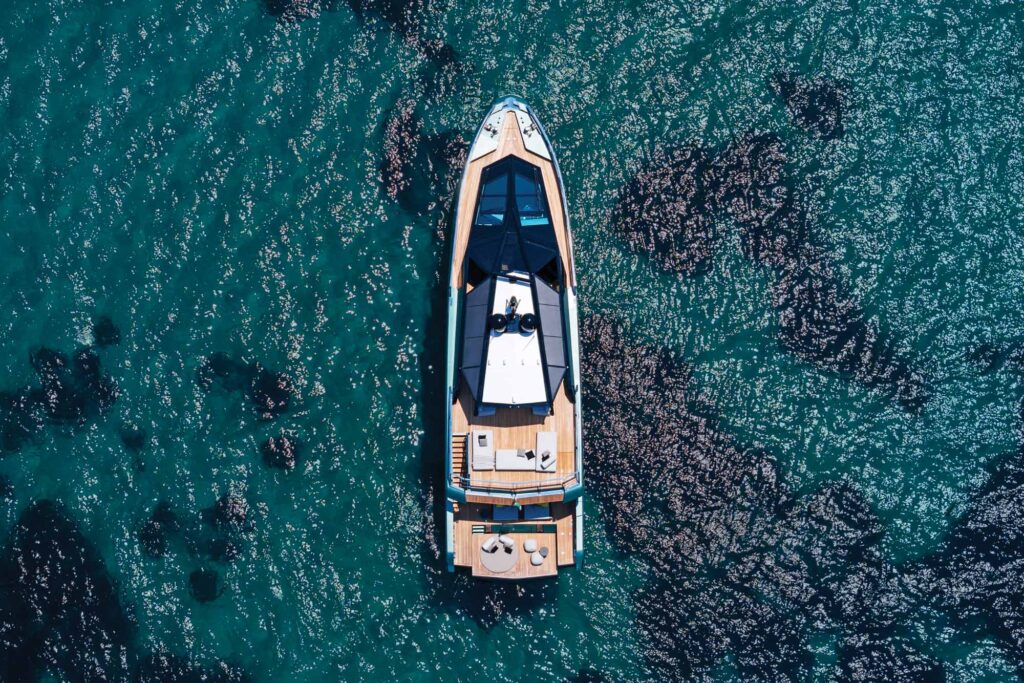 Free-standing furniture in outdoor spaces creates flexible layout options.
Gilles Martin-Raget
Free-standing furniture in outdoor spaces creates flexible layout options.
Gilles Martin-Raget
Wally has always been a disrupter in the yacht world. For more than 30 years, its team has taken what came before, stripped away everything but function, and rethought just about every other aspect. The results have included the original wallytender, the unique wallypower 118, and, more recently, various wallytenders and wallypowers. The trend continues with the 78-foot-8-inch wallywhy150, whose model name refers to volume.
The wallywhy150 is a two-and-a-half-deck design with around 150 gross tons—a spec we don’t often see with yachts this length, but, again, Wally likes to do things differently. The “why” bit of wallywhy is an acronym for Wally Hybrid Yachts, which has nothing to do with hybrid propulsion, but rather references hulls that are optimized for a range of displacement and semidisplacement cruising speeds.
Exterior styling is futuristic, defined by a typically Wally-shaped raised pilothouse and a high, blunt, and slightly reverse-raked bow. The bow design helps punch through seas at semidisplacement speeds and provides plenty of room for a main-deck owners’ stateroom.
Outdoor living is also key to Wally. There are two principal zones on the 150: the cockpit and the upper deck aft. The latter serves as a sun deck with partial protection from a mostly carbon-fiber hardtop that extends aft from that mostly glass raised pilothouse. It’s a vast space, whether used for family fun or as a party venue. The furniture options include free-standing, for maximum flexibility. The wallywhy150 that I got aboard had a dining table forward, a C-booth sofa and a pedestal table amidships, and scattered cushions for lounging aft. A gate to starboard accesses the foredeck, which serves as a technical area for crew.
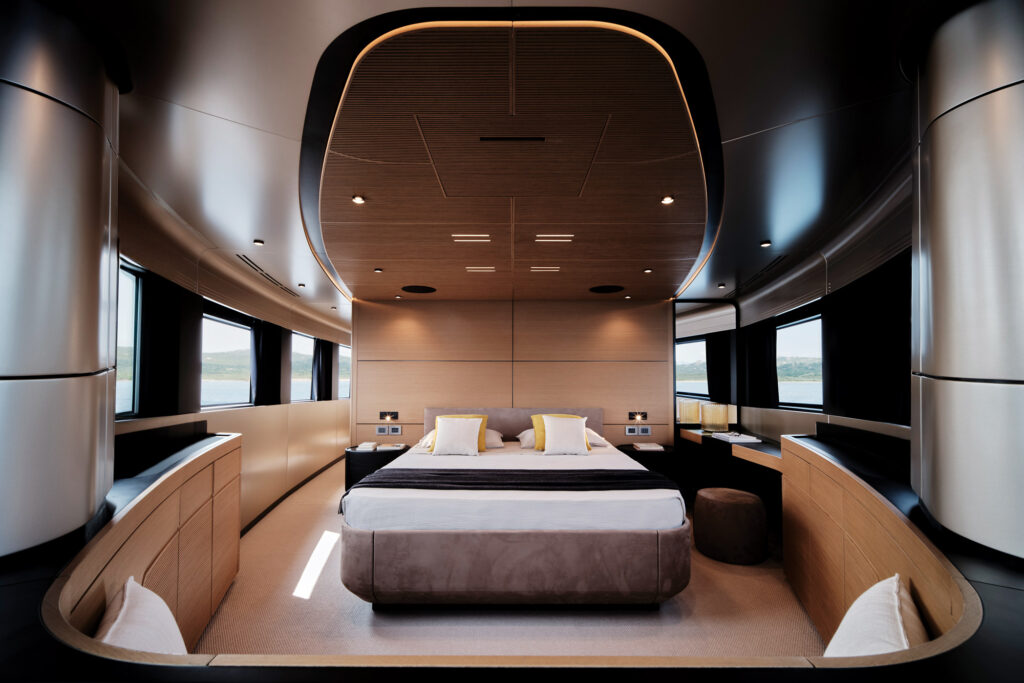 The wallywhy150 maintains its beam forward, adding volume to this main-deck owners’ stateroom.
Toni Meneguzzo
The wallywhy150 maintains its beam forward, adding volume to this main-deck owners’ stateroom.
Toni Meneguzzo
The cockpit, occupying two levels, is the heart of this design. The forward half is at the same level as the after end of the main salon, which is lower than aboard more-conventional yacht designs. The rest of the cockpit is down a step. It has an island sofa amidships with a flippable backrest, so guests can laze facing forward or aft. There is no garage, but the hydraulic stern platform—which is normally flush to the cockpit—will accommodate an 11-foot-6-inch tender, chocked transversely.
Interior design is by Andrea Vallicelli, and the decor of Hull No. 1 is pure Wally: light, satin-varnished veneers with light-dark contrasts. The overall vibe is modern and tending toward minimalism, but with no hint of starkness.
The salon is also a split-level affair. The after end is a dining area with two runs of hullside windows from the main and lower decks, and high ceilings with a double curvature. A day head is in the after port corner. The raised forward half of the salon is all lounges, save for some built-in cabinetry. Free-standing furniture choices, once again, allow owners to personalize the space.
The owners’ stateroom has an access corridor that runs forward along the starboard side from a lobby. The corridor is surprisingly long, enhancing the stateroom’s sense of exclusivity, and it is flanked by picture windows and walk-in closets. The en suite head has twin sinks, a head and bidet, and a shower stall. The sleeping area has a forward-facing king berth and 270 degrees of glazing, including panes that wrap around the stem. Save for a pair of structural mullions, they provide clear views ahead for a “wow” factor.
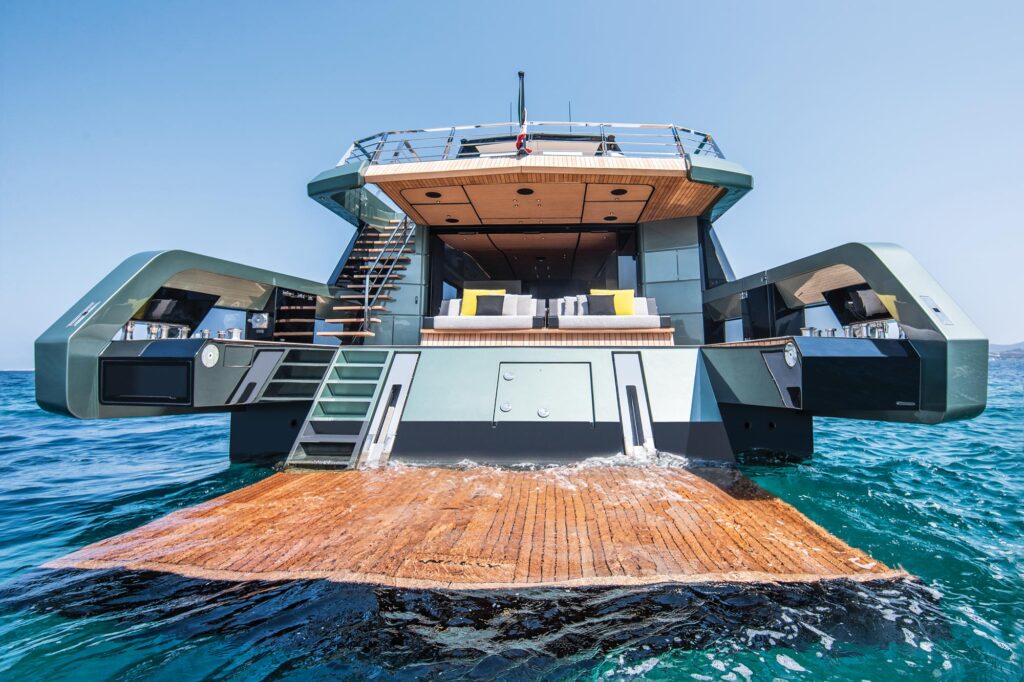 The swim platform rises flush with the cockpit and accommodates an 11-foot-6-inch tender.
Gilles Martin-Raget
The swim platform rises flush with the cockpit and accommodates an 11-foot-6-inch tender.
Gilles Martin-Raget
Wally says that some owners might prefer to use this glorious space for something other than a stateroom, such as an entertainment area with a bar and a dining table. That would leave the entire salon as a two-tier lounge.
Guest accommodations on the lower deck are accessed via a central amidships lobby. There are three staterooms, all en suite. The VIP has an inboard-facing king berth. One guest stateroom has an inboard-facing queen berth, and the other has forward-facing twin berths.
Crew quarters are below the owners’ stateroom, with access from the main-deck galley. These quarters include two en suite cabins with a total of four bunks, although most owners will run with a captain and just two crew.
Standard power is triple 900 hp Volvo Penta D13s and IPS1200 pod drives, which should deliver a top-end speed of around 21 knots. This wallywhy150 had the bigger alternatives: triple 1,000 hp D13s with IPS1350s. Hull No. 1 managed over-the-ground speeds of 22.9 knots one way and 22.6 knots on a reciprocal heading with the Humphree dynamic trim system and Seakeeper gyrostabilizer running. Wally quotes a 23-knot speed at half-load.
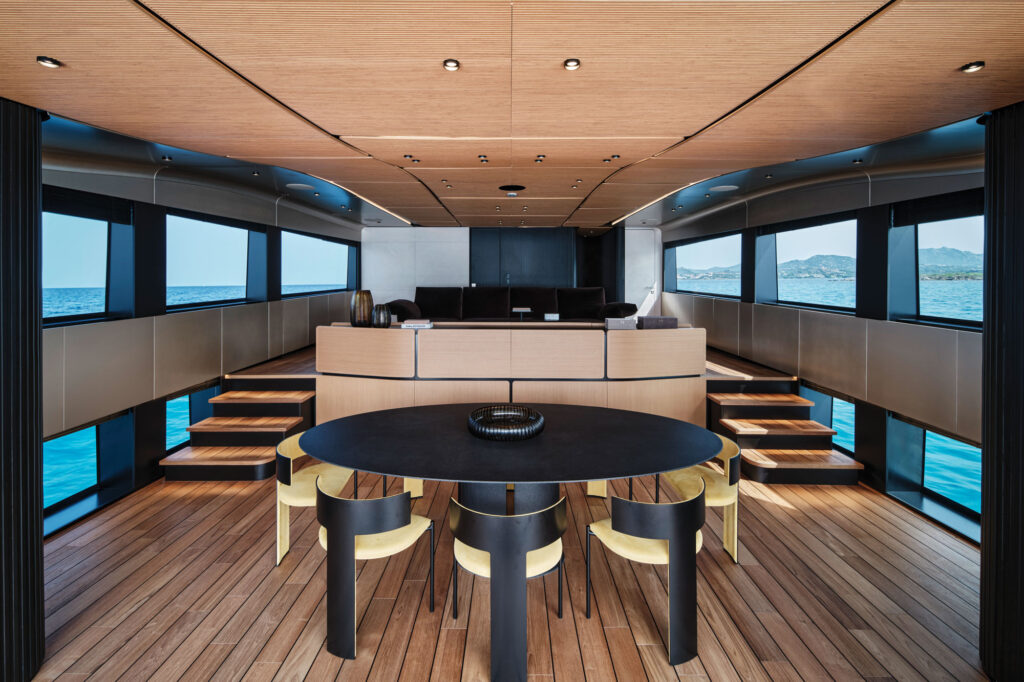 The forward half is at the same level as the after end of the main salon, which is lower than aboard more-conventional yacht designs.
Toni Meneguzzo
The forward half is at the same level as the after end of the main salon, which is lower than aboard more-conventional yacht designs.
Toni Meneguzzo
The ultimate range at 10 knots should be around 1,000 nautical miles, about the same with each engine package. At around 15 knots, this yacht would run for 350 nm, including a 10 percent reserve. Tank capacity is 2,378 gallons.
The wallywhy150 drives nicely, almost sprightly. Visibility is good, although chunky mullions in the raised pilothouse present a few blind spots. The two high-backed carbon-fiber helm seats look like something you would expect to see on a spaceship.
Off Cannes, France, in glorious weather with virtually no swell, this yacht was marvelously quiet. At the helm, I noted about 53 decibels flat-out and just 50 decibels at 10 knots and 1,000 rpm.
While the inside of this yacht may be whisper quiet, the wallywhy150’s forward-thinking design, solid ride, and chic interior speak loudly and proudly to the company’s motto of being 20 years ahead. It’s just what Wally does, again and again.
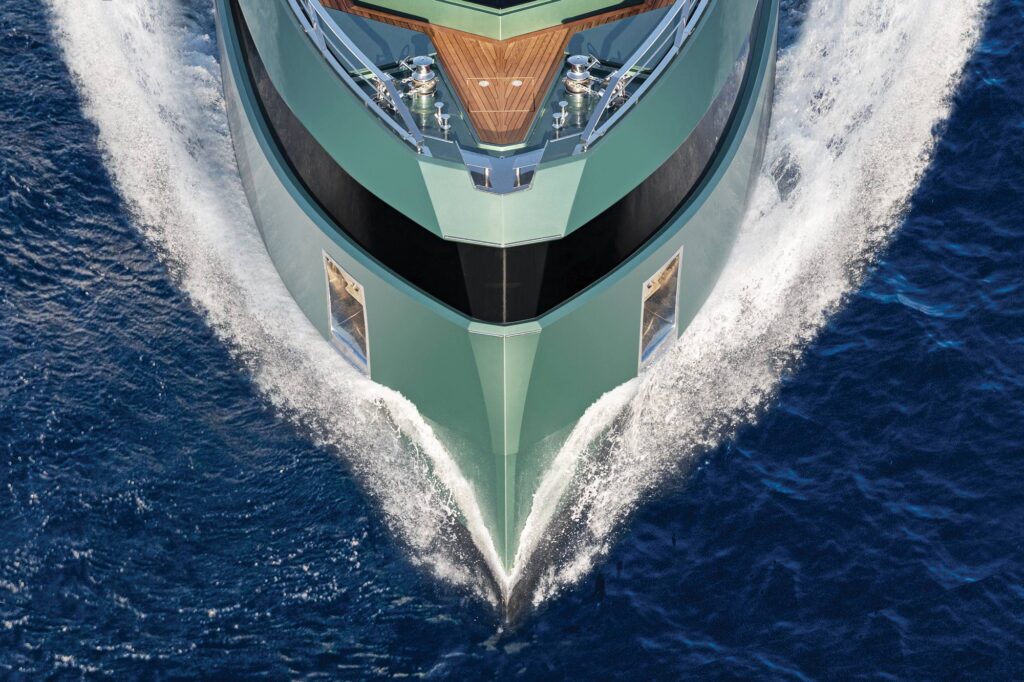 Hull No. 1 achieved over-the-ground speeds of 22.9 knots one way and 22.6 knots on a reciprocal heading.
Gilles Martin-Raget
On a Roll
Hull No. 1 achieved over-the-ground speeds of 22.9 knots one way and 22.6 knots on a reciprocal heading.
Gilles Martin-Raget
On a Roll
The first wallywhy150 was shown at Salone Nautico Venezia 2023 this past May and June in Italy. As this issue went to press, Hull No. 2 had launched, and Hull No. 3 was nearing completion, bound for the US.
Where It’s MadeWallywhys are built at the Ferretti Group’s Mondolfo plant, which was originally home to Pershing. It’s 20 miles northwest of Ancona on Italy’s east coast. A new 750,000-square-foot plant in Ravenna will soon become Wally’s home and a principal production facility.
It’s Easy Being GreenThe first wallywhy150 has a striking metallic-green hull. Stefano de Vivo, the Ferretti Group’s chief commercial officer and Wally CEO, described it as “power gray.” (Like mice and bananas, green is an unlucky word for superstitious mariners.) Various Wallys have been green, including the one that inspired the company’s name, Luca Bassani’s 105-foot ketch Wallygator. It launched in 1994 and was primarily dark green. The wallypower was originally metallic gray-green.
Pursuit of PerfectionChief designer and Wally founder Luca Bassani brings passion to the boatbuilding process. While walking through the wallywhy150 with him, I mentioned that the small, aft-facing bench sofa below the big window in the stem of the owners’ stateroom was perhaps a little underwhelming. Bassani paused and then said: “You’re right, Phil. It needs to be the other way around. Or maybe…”
Later that morning, Bassani was sitting at the table on the upper deck, chatting on his cell. He cupped a hand over the phone and said, “By the way, I have already got the Vallicelli guys coming over later today to talk about what we can do better down there.”
Take the next step: wally.com
The post wallywhy150 Reviewed appeared first on Yachting.
- Home
- About Us
- Write For Us / Submit Content
- Advertising And Affiliates
- Feeds And Syndication
- Contact Us
- Login
- Privacy
All Rights Reserved. Copyright , Central Coast Communications, Inc.